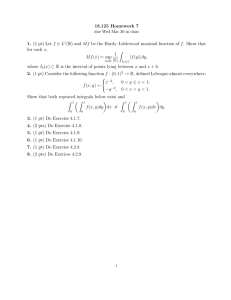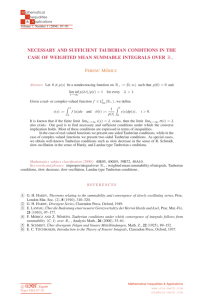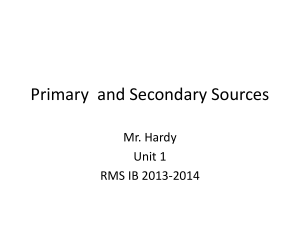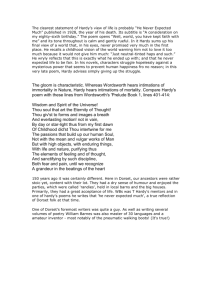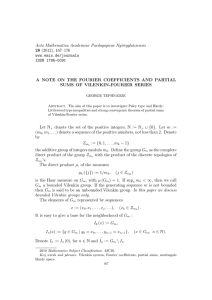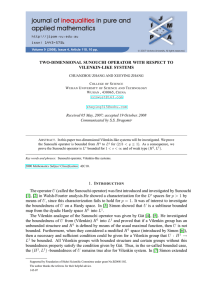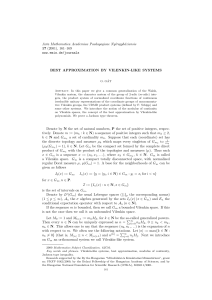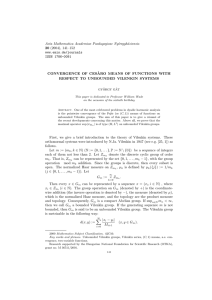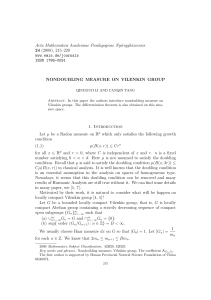A HARDY{LITTLEWOOD{LIKE INEQUALITY ON COMPACT TOTALLY DISCONNECTED SPACES I. Blahota
advertisement
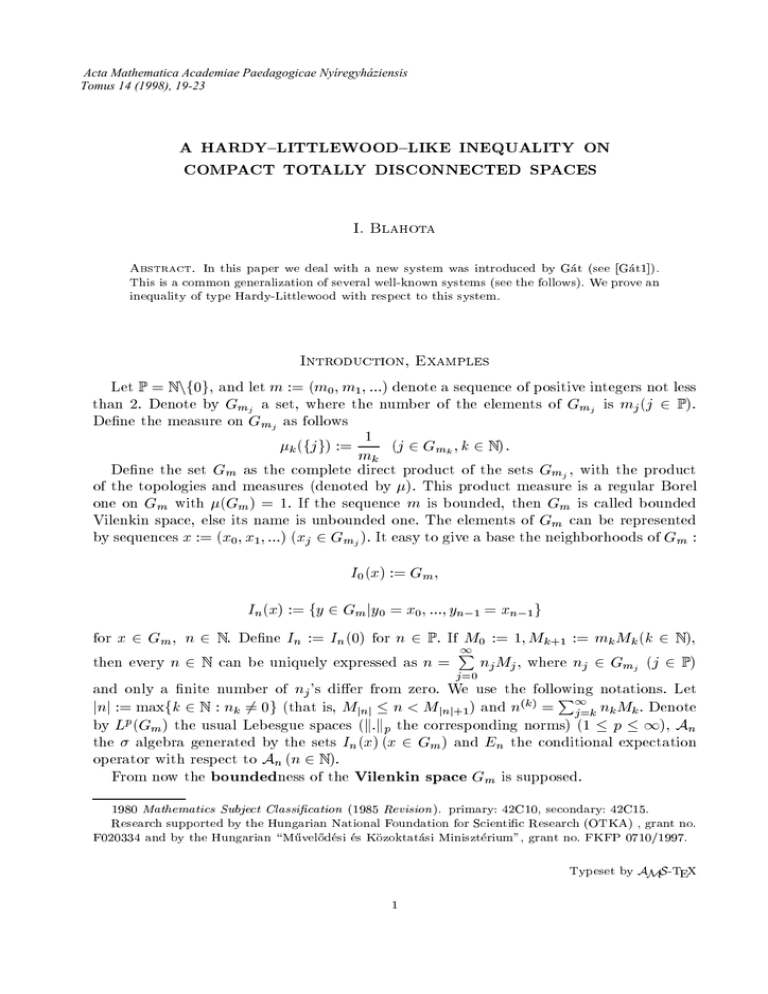
Acta Mathematica Academiae Paedagogicae Nyíregyháziensis
Tomus 14 (1998), 19-23
A HARDY{LITTLEWOOD{LIKE INEQUALITY ON
COMPACT TOTALLY DISCONNECTED SPACES
I. Blahota
Abstract. In this paper we deal with a new system was introduced by Gat (see [Gat1]).
This is a common generalization of several well-known systems (see the follows). We prove an
inequality of type Hardy-Littlewood with respect to this system.
Introduction, Examples
Let P = N nf0g; and let m := (m0 ; m1 ; :::) denote a sequence of positive integers not less
than 2: Denote by Gmj a set, where the number of the elements of Gmj is mj (j 2 P):
Dene the measure on Gmj as follows
k (fj g) := m1 (j 2 Gmk ; k 2 N ) :
k
Dene the set Gm as the complete direct product of the sets Gmj ; with the product
of the topologies and measures (denoted by ). This product measure is a regular Borel
one on Gm with (Gm ) = 1: If the sequence m is bounded, then Gm is called bounded
Vilenkin space, else its name is unbounded one. The elements of Gm can be represented
by sequences x := (x0 ; x1; :::) (xj 2 Gmj ): It easy to give a base the neighborhoods of Gm :
I0 (x) := Gm ;
In (x) := fy 2 Gm jy0 = x0 ; :::; yn,1 = xn,1 g
for x 2 Gm ; n 2 N . Dene In := In (0) for n 2 P. If M0 := 1; Mk+1 := mk Mk (k 2 N );
1
P
then every n 2 N can be uniquely expressed as n = nj Mj ; where nj 2 Gmj (j 2 P)
j =0
and only a nite number of nj 's dier from zero. We use the following
notations. Let
P
1
(k )
jnj := maxfk 2 N : nk 6= 0g (that is, Mjnj n < Mjnj+1) and n = j=k nk Mk . Denote
by Lp (Gm ) the usual Lebesgue spaces (k:kp the corresponding norms) (1 p 1), An
the algebra generated by the sets In (x) (x 2 Gm ) and En the conditional expectation
operator with respect to An (n 2 N ).
From now the boundedness of the Vilenkin space Gm is supposed.
1980 Mathematics Subject Classication (1985 Revision ). primary: 42C10, secondary: 42C15.
Research supported by the Hungarian National Foundation for Scientic Research (OTKA) , grant no.
F020334 and by the Hungarian \M}uvel}odesi es Kozoktatasi Miniszterium", grant no. FKFP 0710/1997.
Typeset by AMS-TEX
1
2
I. BLAHOTA
The concept of the maximal Hardy space H 1(Gm ) is dened by the maximal function
f := supn jEn f j (f 2 L1(Gm )) , saying that f belongs to the Hardy space H 1 (Gm ) if
f 2 L1 (Gm). H 1 (Gm) is a Banach space with the norm
kf kH := kf k
1
1
This deniton is suitable if the sequence m is bounded. In this case a good propery of the
space H 1 (Gm ) is the atomic structure [SWS].
A Rfunction a is said to be atom if a = 1 or a : Gm ! C ; ja(x)j jIn j,1; supp a(x) In
and a(x) = 0: We say that f element is of the Hardy space H (Gm ) (or in brief H ),
In
if there exists j 2C (j 2 P) that
1
P
jj j < 1; and if exists aj (j 2 P) atoms, that
j =1
1
P
f = j aj : Moreover, H is Banach space with the norm
j =1
kf kH := inf
1
X
i=0
ji j;
P
where the inmum is taken over all decompositions f = 1
i=0 i ai 2 H . If the sequence m
is bounded (in this paper this is supposed), then H = H 1 , moreover, the two norms are
equivalent. (If the sequence m is not bounded , then the situation changes.)
Next we introduce on Gm an orthonormal system (see [Gat1]) we call Vilenkin-like
system. The complex valued functions which we call the generalized Rademacher functions
rkn : Gm ! C have these properties:
i. rkn is Ak+1 measurable (i.e. rkn (x) depends only on x0 ; :::; xk (x 2 Gm )), rk0 = 1 for all
k; n 2 N .
ii. If Mk is a divisor of n; l and n(k+1) = l(k+1) (k; l; n 2 N ), then
1 if n = l ;
k k
n
l
Ek (rk rk ) =
0 if nk 6= lk
(z is the complex conjugate of z).
iii. If Mk is a divisor of n (that is, n = nk Mk + nk+1Mk+1 + ::: + njnj Mjnj). Then
mX
k ,1
nk =0
jrkn (x)j = mk
2
for all x 2 Gm .
p
iv. There exists a > 1 for which krkn k1 mk =.
Dene the Vilenkin-like system := ( n : n 2 N ) as follows.
n :=
1
Y
k=0
rkn k ; n 2 N :
( )
Q
A HARDY{LITTLEWOOD...
3
j rn k ). The Vilenkin-like system is orthonormal (see
(Since rk0 = 1, then n := jkn=0
k
[Gat2]).
And now let us list some well-known examples to this system.
1. The Vilenkin and the Walsh system. For more on these see e.g. [SWS, AVD]
2. The group of 2-adic (m-adic) integers (if mk = 2 for each k 2 N then 2-adic). [HR,
SW2, Tai]
3. Noncommutative Vilenkin groups (In this case the group is the cartesian product of
common nite groups.) [GT, Gat2]
4. A system in the eld of number theory. This system (on Vilenkin groups) was a new
tool in order to investigate limit periodic arithmetical functions. [Mau]
5. The UDMD product system (is introduced by F. Schipp on the Walsh-Paley group).
[SW2, SW]
6. The universal contractive projections system (UCP) (is introduced by F. Schipp).
[Sch4])
For more on these examples and their proves see [Gat1].
Finally, let us introduce the usual denitions of the Fourier-analysis. With notation
already adopted for f 2 L1 (Gm ) we dene the Fourier coecients and partial sums by
( )
fb(k) :=
Sn f :=
The Dirichlet kernels:
Dn (y; x) :=
It is clear that
nX
,1
k=0
Z
Gm
f k d
fb(k) k
nX
,1
k=0
Sn f (x) =
(n 2 P; S0 f := 0):
k (y ) k (x)
Z
Gm
(k 2 N )
(n 2 P; D0 := 0):
f (x)Dn(y; x)d(x):
Result and Proof
Theorem. There exists a C > 0 absolute constant that if f 2 H (Gm); then
1
X
k,1 jf^(k)j C kf kH :
k=1
Proof of the theorem. Since f 2 H (Gm ); let us form f :=
1
P
atoms, and jk j < 1:
k=1
1
X
1
P
k ak (x); where ak (x) are
k=1
1
1
1
1
X
X
X
X
,
1 ^
,
1
k jf (k)j = k j j a^i (k)j jj j k,1 ja^j (k)j;
j =1
j =1
k=1
k=1
k=1
4
I. BLAHOTA
that is why it will be sucient to show that there exists C > 0 absolute constant that for
all a(x) atoms
1
X
k,1 ja^(k)j C:
k=1
Let a(x) 2 H (Gm ) be an atom. If a 1 then
Z
jkj
Y
jkj
Y
(j )
k
k(j)
a^(k) =
k = E0 ( k ) = E0 ( rj ) = E0 (Ejkj ( rj )) =
j =1
j =1
Gm
jkY
j,1 (j)
E0( rkj Ejkj(rj0kjrkjk(jk ) )) = 0
j =1
because k(jkj) = kjkjMjkj 6= 0 if k 2 P and Ek (rknrkl ) = 0 if nk 6= lk : In this case the
statement of the theorem is trivial.
So, assume that aR6 1: In this case let In be an interval for which ja(x)j jInj,1 ;
supp a(x) In and a(x) = 0:
In
Since supp a(x) In than
j j
a^(k) =
Z
Gm
Z
a(x) k (x) = a(x) k (x):
In
If k = 0; :::; Mn , 1 than k (x) depend only on the rst n coordinate of x; hence the
function k (x) on the set In is invariable
Z
Z
In
In
a^(k) = a(x) k (x) = c a(x) = 0
1
1
X
X
,
1
=) k ja^(k)j =
k,1 ja^(k)j:
k=1
k=Mn
Using the Cauchy{Buniakovski{Schwarz inequality
v
v
u
u
1
1
1
X
X
X
u
u
,
1
2
t
t
ja^(k)j
k,2;
k ja^(k)j k=Mn
k=Mn
and from Bessel's inequality
k=Mn
v
u
1
X
u
t
ja^(k)j2 ka(x)k2;
k=Mn
A HARDY{LITTLEWOOD...
5
and estimate the approximate sum of the Riemann integral of function x12
v
u
1
X
u
t
k,2 pC :
Mn
k=Mn
These gives
by
1
X
k,1 ja^(k)j C;
Z
k=Mn
ka(x)k = jaj jIn j, jInj = jIn j, Mn = mn Mn CMn ;
2
2
2
2
1
+1
+1
In
because of the boundedness of the sequence m.
This completes the proof of Theorem.
Acknowledgement
I would like to thank Professor G. Gat for setting the problem.
References
[FS] S. Fridli, P. Simon, On the Dirichlet kernels and a Hardy space with respect to the Vilenkin system,
Acta Mathematica Hungarica 45 (1-2) (1985), 223-234.
[AVD] Agaev , G.H., Vilenkin , N.Ja., Dzhafarli , G.M., Rubinstein , A.I., Multiplicative systems of functions and harmonic analysis on 0-dimensional groups (in Russaian), Izd.(\ELM"), Baku, 1981.
[Gat1] Gat,G., On (C; 1) summability of integrable functions on compact totally disconnected spaces, Studia Math. (submitted).
[Gat2] Gat,G., Pointwise convergence of Fejer means on compact totally disconnected groups, Acta Sci.
Math. (Szeged) 60 (1995), 311-319.
[GT] Gat, G., Toledo, R., Lp -norm convergence of series in compact totally disconnected groups, Analysis
Math. 22 (1996), 13-24.
[HR] Hewitt,E. ,Ross,K., Abstract Harmonic Analysis, Springer-Verlag, Heidelberg, 1963.
[Mau] Mauclaire, J.L., Integration et theorie des nombres, Hermann, Paris, 1986.
[Sch4] Schipp, F., Universal conctractive projections and a.e. convergence, Probability Theory and Applications, Essays to the Memory of Jozsef Mogyorodi, Eds.: J. Galambos, I. Katai, Kluwer Academic
Publishers, Dordrecht, Boston, London (1992), 47-75.
[SW] Schipp,F. , Wade,W.R., Norm convergence and summability of Fourier series with respect to certain
product systems in Pure and Appl. Math. Approx. Theory, vol. 138, Marcel Dekker, New York-Basel-Hong Kong, 1992, pp. 437-452.
[SW2] Schipp,F. , Wade,W.R., Transforms on normed elds, Janus Pannonius Tudomanyegyetem, Pecs,
1995.
[SWS] Schipp,F.,Wade,W.R.,Simon,P.,Pal,J., Walsh series: an introduction to dyadic harmonic analysis,
Adam Hilger, Bristol and New York, 1990.
[Tai] Taibleson,M.H., Fourier Analysis on Local Fields, Princeton Univ. Press., Princeton ,N.J., 1975.
[Vil] Vilenkin , N.Ja., On a class of complete orthonormal systems (in Russian), Izv. Akad. Nauk. SSSR,
Ser. Math. 11 (1947), 363-400.
Bessenyei College, Dept. of Math., Nyregyhaza, P.O.Box 166., H{4400,Hungary
E-mail : blahota@ny1.bgytf.hu
(Received October 1, 1997)

